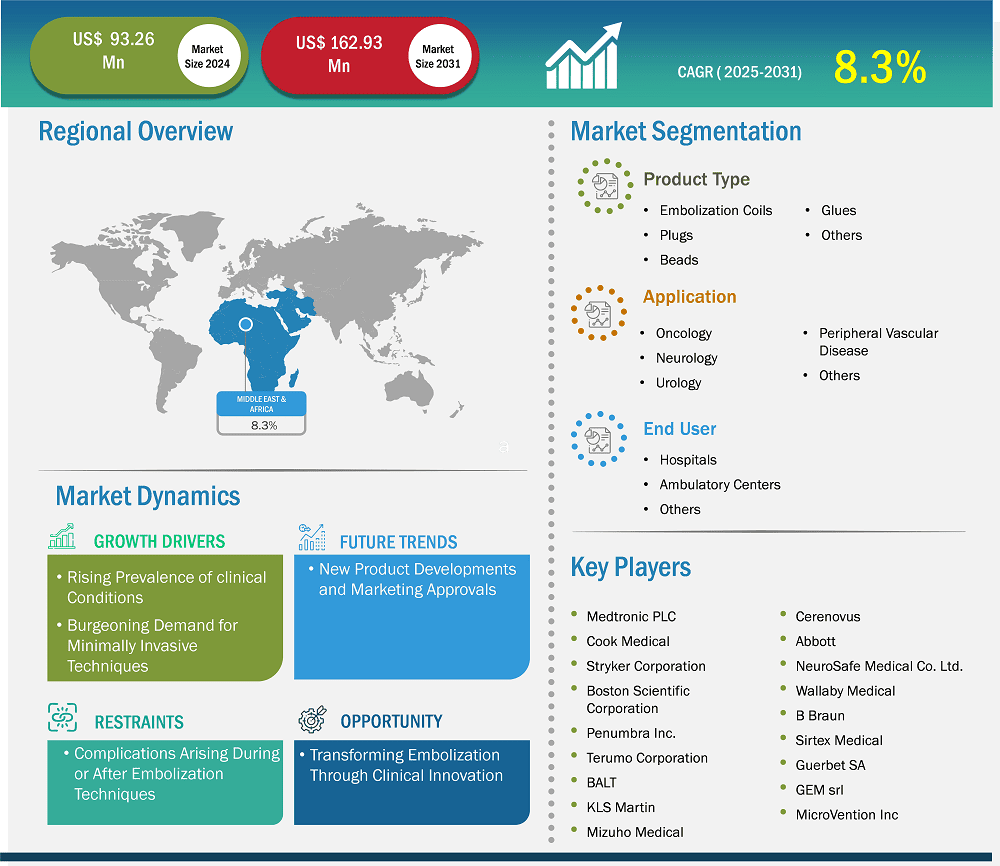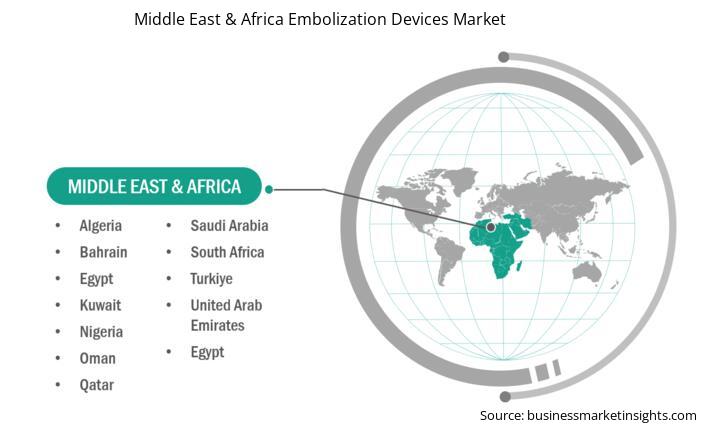Middle East & Africa Embolization Devices Market Report (2021-2031) by Scope, Segmentation, Dynamics, and Competitive Analysis
No. of Pages: 176 | Report Code: BMIRE00032149 | Category: Life Sciences
No. of Pages: 176 | Report Code: BMIRE00032149 | Category: Life Sciences
The Middle East & Africa embolization devices market size is expected to reach US$ 162.93 million by 2031 from US$ 93.26 million in 2024. The market is estimated to record a CAGR of 8.3% from 2025 to 2031.
The embolization devices market in the Middle East & Africa is segmented into the UAE, Saudi Arabia, South Africa, and the Rest of Middle East & Africa. The regional market growth is attributed to technological advancements and developments by market players. Also, factors such as rising healthcare infrastructure, increasing prevalence of chronic conditions, supportive government plans, and growing strategic initiatives by market players boost the Middle East & Africa embolization devices market growth. Furthermore, the acceptance and integration of modern technologies drive the market growth in the region. Furthermore, increasing healthcare investments and infrastructure development in countries like the UAE and Saudi Arabia have facilitated the adoption of advanced medical technologies. These investments have led to better healthcare facilities and trained professionals, further driving the demand for embolization devices.

Key segments that contributed to the derivation of the Middle East & Africa embolization devices market analysis are type, application, and end user.
Vascular diseases, including peripheral artery disease (PAD), aneurysms, and arteriovenous malformations (AVMs), are becoming more prevalent globally. These conditions have become particularly common among geriatric populations and individuals exposed to lifestyle-related risk factors. Peripheral vascular disease (PVD) consists of PAD and venous disease.
Almost 500,000 people die worldwide due to brain aneurysms each year. Brain aneurysms are most prevalent in people from the age group of 35–60, and most aneurysms develop after the age of 40. Additionally, ruptured brain aneurysms account for 3–5% of all new strokes.
As per the World Health Organization (WHO), postpartum hemorrhage is the foremost cause of maternal mortality globally. About 14 million women experience this each year, resulting in about 70,000 maternal deaths worldwide. Additionally, as per the Institute for Functional Medicine, the prevalence of uterine fibroids has increased a predictable 78.82% in the past 30 decades, from 126.41 million to 226.05 million cases.
These clinical conditions can be effectively treated using embolization devices as these tools are designed to block abnormal or excessive blood flow within blood vessels, and this technique is preferred due to its minimally invasive nature. Embolization involves the deliberate occlusion of blood vessels to treat conditions such as aneurysms, postpartum hemorrhage, uterine fibroids, and certain types of tumors. Embolization is used to control severe bleeding after childbirth when conventional methods are ineffective, as well as blocks the blood supply to fibroids, causing them to shrink and symptoms to improve. Thus, the escalating burden of these conditions fuels the growth of the embolization devices market.
Based on country, the Middle East & Africa embolization devices market comprises Saudi Arabia, South Africa, the UAE, and the Rest of Middle East & Africa. South Africa held the largest share in 2024.
Saudi government's Vision 2030 initiative aims to enhance the healthcare sector by increasing private sector participation and investing in medical infrastructure. For instance, the Ministry of Health of Saudi Arabia announced plans to construct several hospitals across the country in 2019. Moreover, the Gulf Cooperation Council (GCC) announced plans to invest US$ 66.67 billion (SR 250 billion) in healthcare infrastructure, aiming to boost private sector participation from 40% to 65% by 2030. These efforts support the development of a more robust healthcare system, in turn fueling the adoption of advanced medical devices, including embolization technologies.
| Report Attribute | Details |
|---|---|
| Market size in 2024 | US$ 93.26 Million |
| Market Size by 2031 | US$ 162.93 Million |
| CAGR (2025 - 2031) | 8.3% |
| Historical Data | 2021-2023 |
| Forecast period | 2025-2031 |
| Segments Covered |
By Type
|
| Regions and Countries Covered | Middle East and Africa
|
| Market leaders and key company profiles |
|
Some of the key players operating in the market include Medtronic Plc; Cook Medical Holdings LLC; Stryker Corp; Boston Scientific Corp; Terumo Corp; Johnson & Johnson; Abbott Laboratories; NeuroSafe Medical Co. Ltd; Wallaby Medical; Sirtex Medical Ltd; GEM srl; Penumbra Inc.; Balt; Lepu Medical Technology Beijing Co Ltd; INVAMED; Meril Life Sciences Pvt Ltd; Merit Medical Systems Inc; and Lifetech Scientific Corp among others. These players are adopting various strategies such as expansion, product innovation, and mergers and acquisitions to provide innovative products to their consumers and increase their market share.
The following methodology has been followed for the collection and analysis of data presented in this report:
The research process begins with comprehensive secondary research, utilizing both internal and external sources to gather qualitative and quantitative data for each market. Commonly referenced secondary research sources include, but are not limited to:
Note: All financial data included in the Company Profiles section has been standardized to USD. For companies reporting in other currencies, figures have been converted to USD using the relevant exchange rates for the corresponding year.
The Insights Partners conducts a significant number of primary interviews each year with industry stakeholders and experts to validate its data analysis and gain valuable insights. These research interviews are designed to:
Primary research is conducted via email interactions and telephone interviews, encompassing various markets, categories, segments, and sub-segments across different regions. Participants typically include:

The Middle East & Africa Embolization Devices Market is valued at US$ 93.26 Million in 2024, it is projected to reach US$ 162.93 Million by 2031.
As per our report Middle East & Africa Embolization Devices Market, the market size is valued at US$ 93.26 Million in 2024, projecting it to reach US$ 162.93 Million by 2031. This translates to a CAGR of approximately 8.3% during the forecast period.
The Middle East & Africa Embolization Devices Market report typically cover these key segments-
The historic period, base year, and forecast period can vary slightly depending on the specific market research report. However, for the Middle East & Africa Embolization Devices Market report:
The Middle East & Africa Embolization Devices Market is populated by several key players, each contributing to its growth and innovation. Some of the major players include:
The Middle East & Africa Embolization Devices Market report is valuable for diverse stakeholders, including:
Essentially, anyone involved in or considering involvement in the Middle East & Africa Embolization Devices Market value chain can benefit from the information contained in a comprehensive market report.